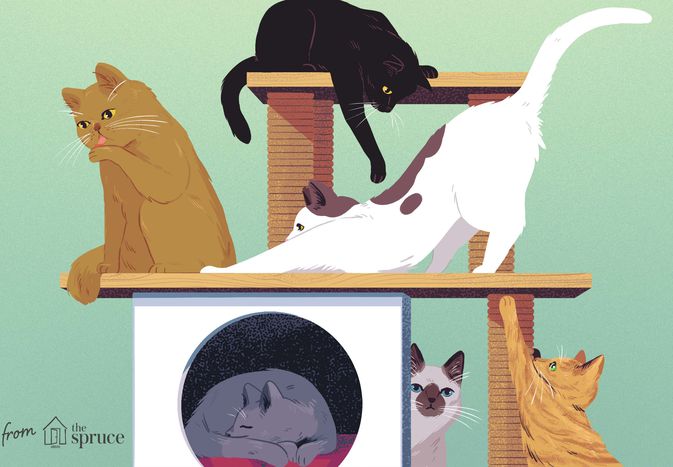Knowing how to tell if a cat is a boy or a girl isn't always as apparent as you'd think. Compared to a female cat, the traits of a male cat aren't always evident to new cat owners, and it's even more challenging to determine the sex of a kitten or a neutered male.
However, telltale signs and behaviors can make it easier to determine a cat's sex. Determining a cat's gender involves examining their physical characteristics.
For instance, male cats have a more prominent and wider space between the anus and the urinary opening. Female cats, on the other hand, have a shorter distance between the anus and genital opening, with no scrotum present.
These are just a few examples of physical characteristics that can help you identify if a cat is a girl or a boy. In some cases, a veterinarian may need to confirm the cat's gender, especially in younger kittens or cats with ambiguous physical features.
Sexing Kittens
For those adopting a kitten, chances are the new pet is only a few weeks old. Newborn and tiny kittens are so immature that it's nearly impossible to tell their sex.
Once they're six or eight weeks old, their genitalia becomes more visually obvious. The penis, however, is not normally visible in male cats, and it's unlikely that the owner will be able to feel or see the scrotum. This apparent lack of a penis or testes is not an indication that a kitten is female.
As a rule of thumb, breeders use "punctuation marks" to identify the sex of younger cats or neutered cats. To do this, raise the pet's tail gently; start by petting gently and try scratching the cat's lower back as he or she may raise the tail automatically as purring begins.
Female cats: When looking at a female cat's genital area, the space just under her tail, it will look like an upside down exclamation point (¡) with the long slit of the vaginal area below the anus. The anus and vagina are typically only about half an inch apart. In kittens, the anus and vagina may both look like dots, and they may be even closer together.
Male cats: The male cat has a larger separation between the anus and the penis, with the testicles in the middle. Both of these openings look more like dots, circles, or a colon (:) than like slits or lines.

Sexing Grown Cats
For those adopting a grown cat, use the same sexing technique as for kittens; this usually works well for both neutered and "whole" cats. If a pet is not spayed or neutered, it'll be easier to determine its sex based on appearance and behavior.
Once cats are spayed or neutered, there is no obvious behavior difference between the genders; apparent differences are likely related to individual cat temperaments.
"Whole" Cats
Tomcats that have not been neutered have readily evident testicles and a broader jowl. They also have unique behaviors that begin as they reach maturity. Un-neutered male cats tend to be more active and aggressive. They're also more likely to mark their territory through urine spraying than neutered toms.
A female cat who hasn't been spayed will go into heat roughly every two weeks when in season. During this time, her behavior can change drastically as she attempts to find a mate. During this time, un-spayed female cats are typically more demanding of attention and vocally louder.
Spayed and Neutered Cats
Spayed female cats will still show the upside down "!," but if she is adopted as an adult, hormonal tests can be used to determine if she is spayed. With female cats, it's important to find out if they've been spayed or not before having an unplanned litter.
Most neutered male cats will still show the vestigial remnants of a testicle sac, and the anus and penis will still be relatively close together. Neutered cats will not display typical male or female behaviors. Neutered males are generally more passive than "whole" males and spayed females do not go into heat.
Sex-Based Differences in Appearance
While all cats look very similar, some colors and physical indications are unique to a particular gender.
Specifically, it is extremely rare for a male cat to have tri-colored calico or orange-and-black tortoiseshell fur. For those with a calico or tortie cat, chances are very good that the pet is a female.
It is uncommon for a female cat to have orange or ginger-colored (or orange-and-white striped) fur. For those with an orange cat, there's a good chance that it is a male.
A cat that has given birth is far more likely to have visually obvious nipples (though both males and females do have nipples).
Females going through heat may have a small amount of mucoid vaginal discharge, and a pregnant cat will have a low-hanging, distended belly.
Related Article

How to Solve Behavior Problems in Cats
Like humans, cats experience fear, pleasure, hunger, anxiety, frustration, and many other emot

How to Stop Loud Meowing in Cats
As you probably already know, cats make a variety of noises. Some breeds, such as Siamese cats, are

Are Ant Traps Safe for Cats?
Ants can be annoying pests and keeping them out of your home can be difficult, especially in the sp

Are Daffodils Poisonous to Cats?
Spring flowers are always a welcome sight after a long, dark winter. Not all spring flowers are saf

Luxating Patella in Cats
Luxating patella, the technical term for a kneecap popping out of place, creates instability in a c

Infectious Diseases in Cats
Bringing a new cat into the family can be an exciting experience. But just like children, they are

Feline Viral Rhinotracheitis (FVR) in Cats
Feline viral rhinotracheitis (FVR), a type of herpes virus, is a common disease in cats that causes

Devon Rex: Cat Breed Profile, Characteristics & Care
The Devon rex is known for their alien-like appearance, marked by large, low-set ears, bi
About FleaFree Feline
We are a premier digital platform committed to delivering high-quality content to our readers. Our mission is to provide accurate, reliable, and engaging information that adds value to our audience's daily lives.
Our team consists of experienced content creators and subject matter experts who uphold the highest standards of professionalism. In an era of information overload, we curate content with care, ensuring our users receive only the most relevant and trustworthy information.
Beyond just reporting facts, we focus on depth and context. Through expert analysis, comprehensive research, and clear presentation, we help our audience gain meaningful insights and make informed decisions.
We take pride in being a trusted information source for our growing community of readers. Our user-first approach means we continuously adapt to provide content that meets our audience's evolving needs and interests.
Innovation and excellence drive everything we do. We're committed to improving our platform and services to deliver the best possible experience for our users.


Comments on " How Do I Tell If a Cat is a Girl or a Boy?" :